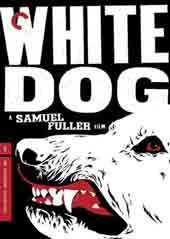
 |
|
|
|
In the early 1980s Sam Fuller was enjoying a rebirth of his theatrical directing career, which had slowed to a crawl after 1964's The Naked Kiss. 1980 brought the release of The Big Red One, a project with strong personal significance for the director. Shortly thereafter came the daring White Dog, a full return to Fuller's hard-hitting journalistic style: loud, bold and to the point. Fresh from his Paramount hit Airplane!, producer Jon Davison knew that White Dog had the kind of gut-level attraction favored by the director. Fuller and writer Curtis Hanson shaped Romain Gary's provocative source story into a compassionate Lassie Come Home tale -- but with a savage horror angle. Young actress Julie (Kristy McNichol) runs over a stray German Shepherd in the Hollywood hills. The dog's recovery period is a bonding experience, and Julie decides to keep it. But one night the dog returns covered in blood. Later, it attacks one of Julie's friends. She takes the animal to the show-biz menagerie run by animal trainers Carruthers and Keys (Burl Ives & Paul Winfield). The men make a shocking discovery: Julie's animal is a "White Dog," a beast programmed by racists to kill black people. Keys is obsessed with White Dogs, and determines to break Julie's Shepherd of its conditioned behavior. When the dog escapes and kills a man, Keys insists on going forward with his experiment, even though harboring a deadly animal exposes all of them to legal jeopardy. Can Keys break the dog's attack conditioning? An old dog can learn new tricks, but can it forget old ones? Davison says that there was no studio interference with the production. But the NAACP publicly accused the movie of racism, which may have prompted Paramount's decision to not release White Dog in America. Sam Fuller was heartbroken, as he felt he'd made a worthy film with a strong anti-racist statement. The Los Angeles cable TV Z Channel screened White Dog not long afterward, and then the movie more or less disappeared. Paramount was not in the habit of shelving movies with profit potential; it was then the home of the trashy, lucrative Friday the 13th series. White Dog has more than enough tension and violence for exploitation purposes; we're forever wondering who will be the next victim. The very next year, Warners enjoyed a solid hit with a killer dog movie, Stephen King's horror adaptation Cujo. White Dog's underlying metaphor is both valid and powerful. We see no black Americans being mistreated by redneck whites, only the actions of a sinister, lethal animal. The dog wasn't born with a racial attack trigger; it was beaten into him as a puppy. White Dog therefore identifies human racism as an infection passed from adult to child. As the song says in South Pacific, "You've Got to Be Taught." The direct references to racism are carefully tempered. Keys explains that white slave owners 200 years ago bred and trained White Dogs to catch escaped slaves -- and presumably to terrorize slaves considering escape. Julie asks how they trained dogs to catch escaped white men, and Keyes just frowns. Julie's a nice girl, but she just doesn't "get it" yet. Keyes' efforts to re-train her dog aren't really about the dog. He's really hoping to establish that a racist can be re-educated. Julie's new dog is intensely loyal. It saves Julie from a rapist but also savages the operator of a street cleaning machine. The dog attacks an African-American actress working with Julie on a film set (which references a scene from Fuller's The Naked Kiss). And when the dog escapes from the training compound, we know it will go for the throat of the first black person it sees. The beast narrowly misses catching sight of a small black child. Just seconds later, it pursues a victim into a church. Typical of Fuller, the scene concludes with an in-our-face graphic: a stained glass window showing Saint Francis of Assisi standing over a peaceful white dog. The dog is a constant menace, a killer monster. Sam Fuller appears briefly as Julie's agent, and Christa Lang-Fuller is a veterinarian urging Julie to have the dog euthanized. Paul Bartel, Marshall Thompson and Neyle Morrow play filmmakers on the movie set and our old friend Dick Miller is glimpsed as one of Carruthers' animal trainers. Criterion's DVD of White Dog is an excellent enhanced transfer that looks much better than older full-frame presentations. Disc producer Susan Arosteguy has assembled a fascinating making-of docu built around interviews with producer Davison, co-writer Curtis Hanson, Christa Lang-Fuller and others. We get the idea that White Dog was an important project for all of them. Davison becomes emotional when he laments the film's effect on Sam Fuller's subsequent career. 
In a separate interview, trainer and actor Karl Lewis Miller explains his use of multiple dog actors and his special methods to create the frightening attack sequences. I don't remember seeing any explanation of special effects for the dog; it's possible that his snarling muzzle is a makeup trick in some shots. Whatever it is, it's very disturbing. A gallery of photos is present, along with an insert booklet containing essays by J. Hoberman and Armond White. Also included is a novelty "interview with the White Dog" written by Sam Fuller to publicize and explain his unusual film. An earlier, more vicious cover art design has been replaced with an image that places the White Dog against a symbolic white background. Unreasoning hatred permeates our entire culture, not just the dog.
On a scale of Excellent, Good, Fair, and Poor,
White Dog rates:
Reviews on the Savant main site have additional credits information and are often updated and annotated with reader input and graphics.
Review Staff | About DVD Talk | Newsletter Subscribe | Join DVD Talk Forum |
| ||||||||||||||||||